Abstract
The relations of lung function and chest radiographic appearances with exposure to inspirable dust were examined in 634 workers in five wool textile mills in west Yorkshire, randomly selected to represent fully the range of current exposures to wool mill dust. Most of these workers could be categorised into three large sex and ethnic groups; European men, Asian men, and Asian women. Exposures to inspirable dust had been measured at a previous survey and time spent in current job, and in the industry were used as surrogates for lifetime cumulative exposures. Chest radiographs were interpreted on the International Labour Office (ILO) scale by three medically qualified readers, and the results combined. Profusions of small opacities of 0/1 on the ILO scale, or greater, were present in only 6% of the population, and were not positively associated with current exposure to wool mill dust, or duration of exposure. In general, statistically significant relations between exposure and lung function indices were not found, with the exception of an inverse relation between the forced expiratory volume/forced vital capacity ratio and dust concentration in European women. A suggestive but not statistically significant inverse relation between FVC and current dust concentration was seen in Asian men. Substantial differences were found between mills in mean values of lung function variables after adjustment for other factors but these were not apparently related to the differences in dust concentrations between these mills. Dyeworkers and wool scourers (mostly European men in relatively dust free jobs) on average experienced an FEV1 251 ml lower than other workers when age, height, smoking habits, and occupational factors had been taken into account. Twenty four per cent of the workforce responded to intracutaneous application of one or more common allergens (weal diameter at least 4 mm), only 12 (7.9%) of these responding to wool extracts. Atopic subjects did not appear to have an increased susceptibility to the effects of inspirable wool dust on lung function. These studies suggest that exposure to wool mill dust may cause functional impairment in some workers but there is little indication from these data of frequent or severe dust related functional deficits. More detailed estimates of cumulative dust exposure by reconstruction of exposure histories might clarify associations between exposure to dust and lung function. These chest radiographic findings provide no evidence that exposure to wool mill dust is related to lung fibrosis.
Full text
PDF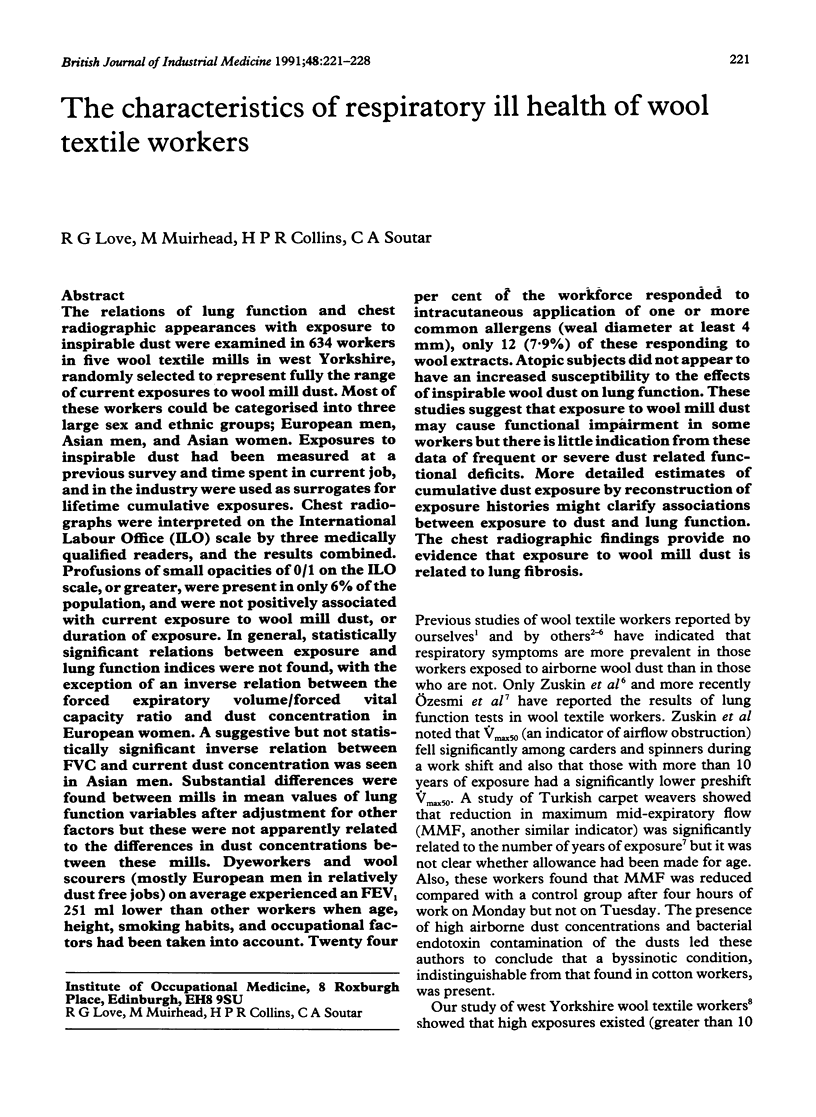
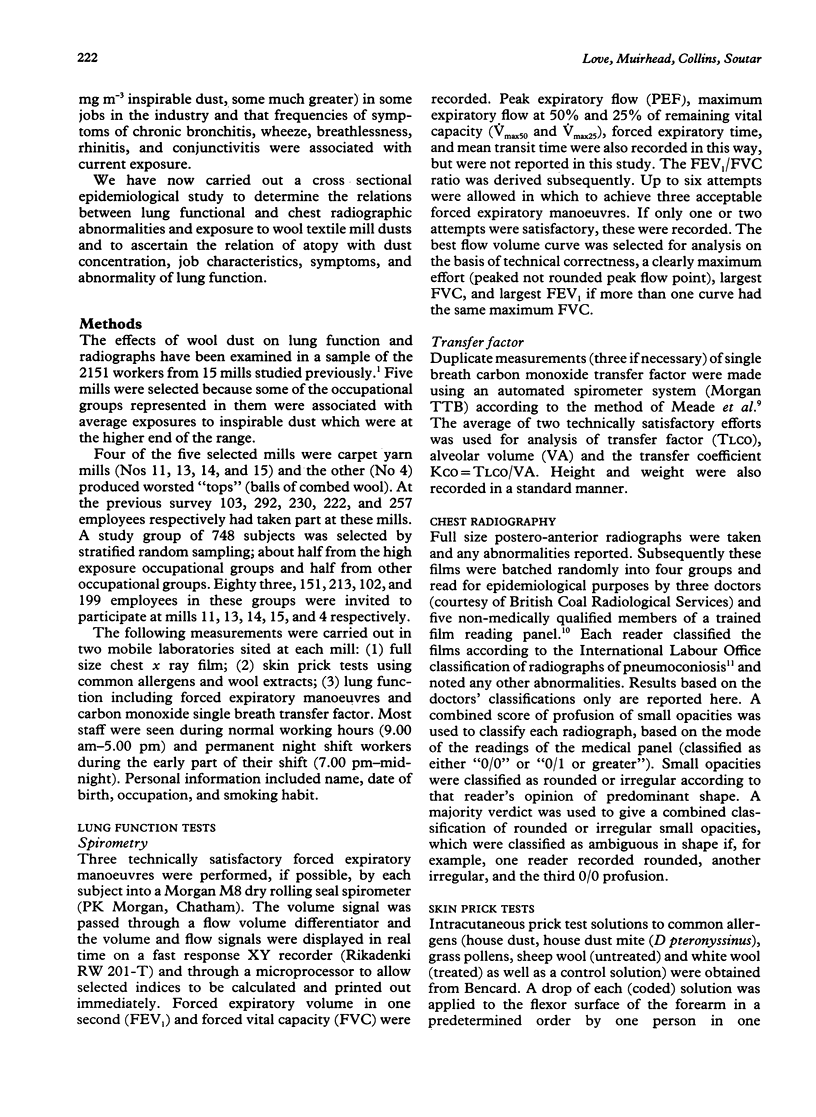
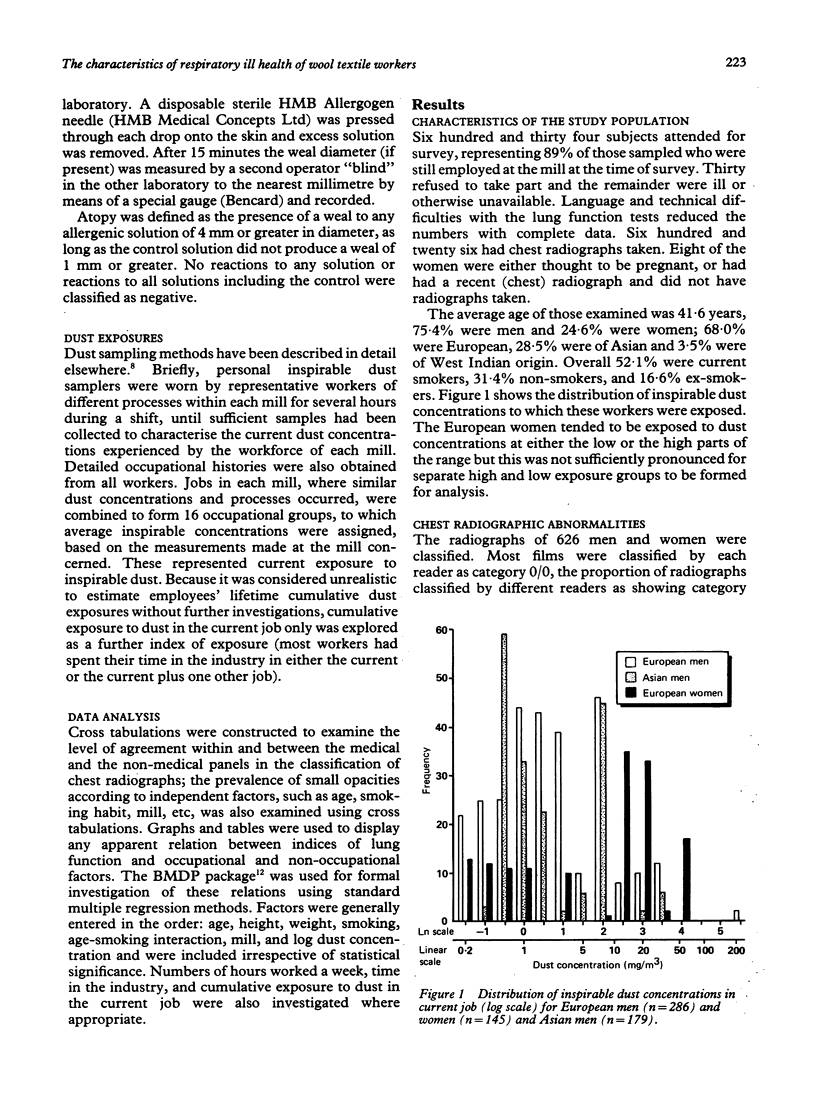
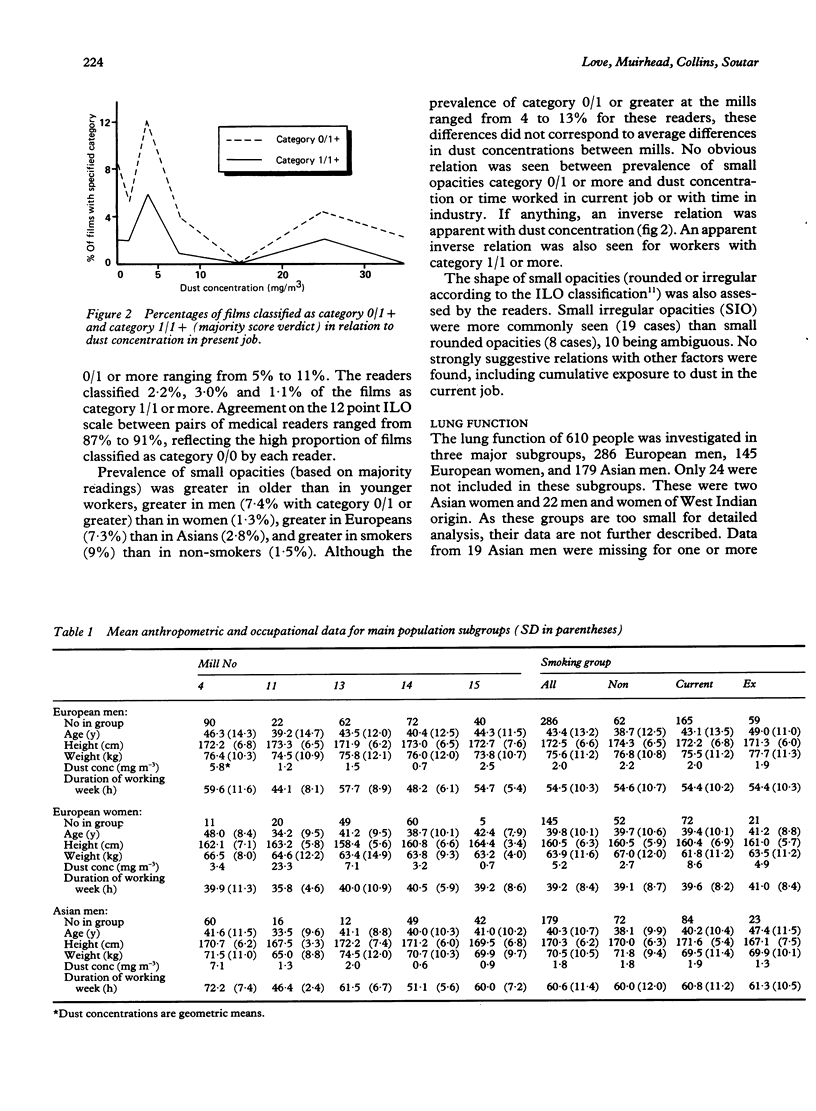
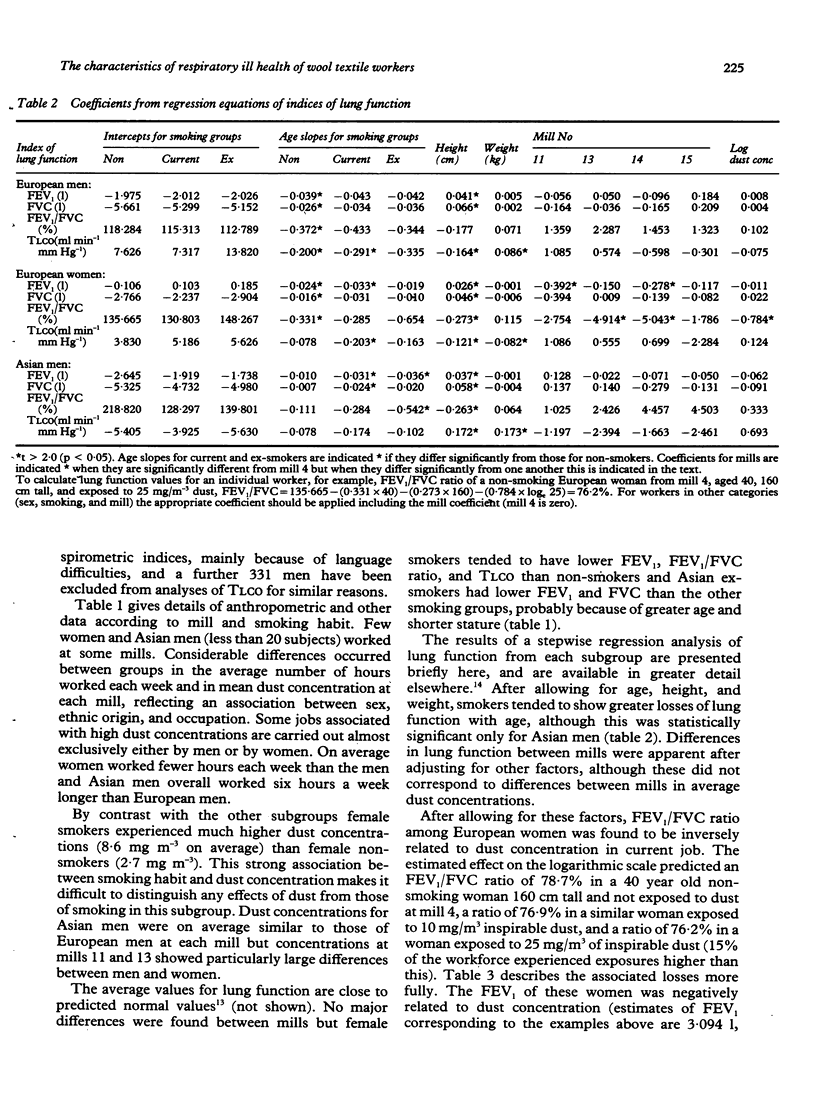

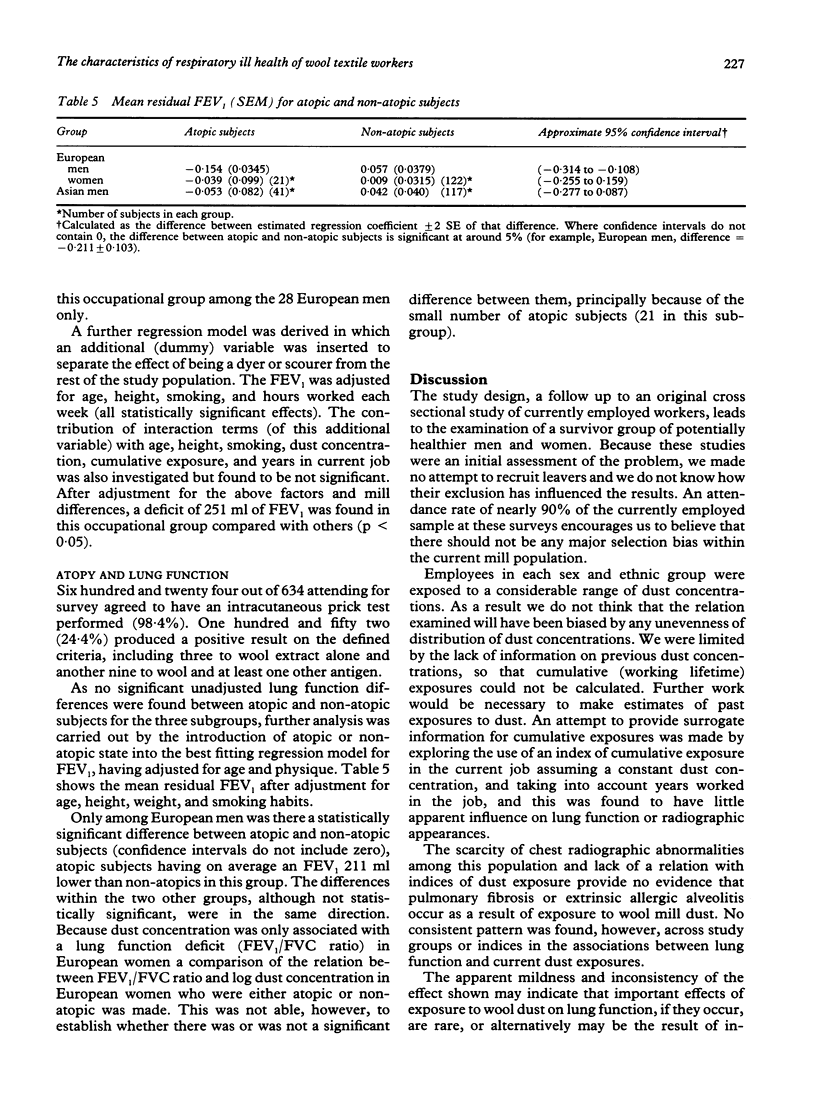

Selected References
These references are in PubMed. This may not be the complete list of references from this article.
- Allardice J. T., Clarke E. C., Jones R. D. A study of the prevalence of epistaxis and respiratory symptoms in carpet backwinders. J Soc Occup Med. 1983 Jan;33(1):36–41. doi: 10.1093/occmed/33.1.36. [DOI] [PubMed] [Google Scholar]
- Brysiewicz K., Buluk H., Cesarz-Fronczyk M., Kordecka J., Leszczyński B., Lukjan Z., Sadokierska H. Wpływ pracy w warunkach zapylenia na czestoś wystepowania przewlekłych zapaleń oskrzeli u pracowników zakładów przemysłu wełnianego im. Sierzana w Białymstoku. Gruzlica. 1970;38(7):657–661. [PubMed] [Google Scholar]
- Copland L., Burns J., Jacobsen M. Classification of chest radiographs for epidemiological purposes by people not experienced in the radiology of pneumoconiosis. Br J Ind Med. 1981 Aug;38(3):254–261. doi: 10.1136/oem.38.3.254. [DOI] [PMC free article] [PubMed] [Google Scholar]
- Docker A., Wattie J. M., Topping M. D., Luczynska C. M., Newman Taylor A. J., Pickering C. A., Thomas P., Gompertz D. Clinical and immunological investigations of respiratory disease in workers using reactive dyes. Br J Ind Med. 1987 Aug;44(8):534–541. doi: 10.1136/oem.44.8.534. [DOI] [PMC free article] [PubMed] [Google Scholar]
- Heederik D., Miller B. G. Weak associations in occupational epidemiology: adjustment for exposure estimation error. Int J Epidemiol. 1988 Dec;17(4):970–974. doi: 10.1093/ije/17.4.970. [DOI] [PubMed] [Google Scholar]
- Jórdeczka S., Basa S., Basa B. Czestoś wystepowania przewlekłej nieswoistej choroby oskrzelowo-płucnej u pracowników przemysłu wełnianego. Gruzlica. 1970;38(7):643–650. [PubMed] [Google Scholar]
- Love R. G., Smith T. A., Gurr D., Soutar C. A., Scarisbrick D. A., Seaton A. Respiratory and allergic symptoms in wool textile workers. Br J Ind Med. 1988 Nov;45(11):727–741. doi: 10.1136/oem.45.11.727. [DOI] [PMC free article] [PubMed] [Google Scholar]
- Mathur K. C., Misra S. N. Incidence of pulmonary diseases among wool workers. Indian J Chest Dis. 1972 Jul;14(3):172–178. [PubMed] [Google Scholar]
- Meade F., Saunders M. J., Hyett F., Reynolds J. A., Pearl N., Cotes J. E. Automatic measurement of lung function. Lancet. 1965 Sep 18;2(7412):573–575. doi: 10.1016/s0140-6736(65)90874-3. [DOI] [PubMed] [Google Scholar]
- Ozesmi M., Aslan H., Hillerdal G., Rylander R., Ozesmi C., Baris Y. I. Byssinosis in carpet weavers exposed to wool contaminated with endotoxin. Br J Ind Med. 1987 Jul;44(7):479–483. doi: 10.1136/oem.44.7.479. [DOI] [PMC free article] [PubMed] [Google Scholar]
- Zuskin E., Valic F., Bouhuys A. Effect of wool dust on respiratory function. Am Rev Respir Dis. 1976 Oct;114(4):705–709. doi: 10.1164/arrd.1976.114.4.705. [DOI] [PubMed] [Google Scholar]


